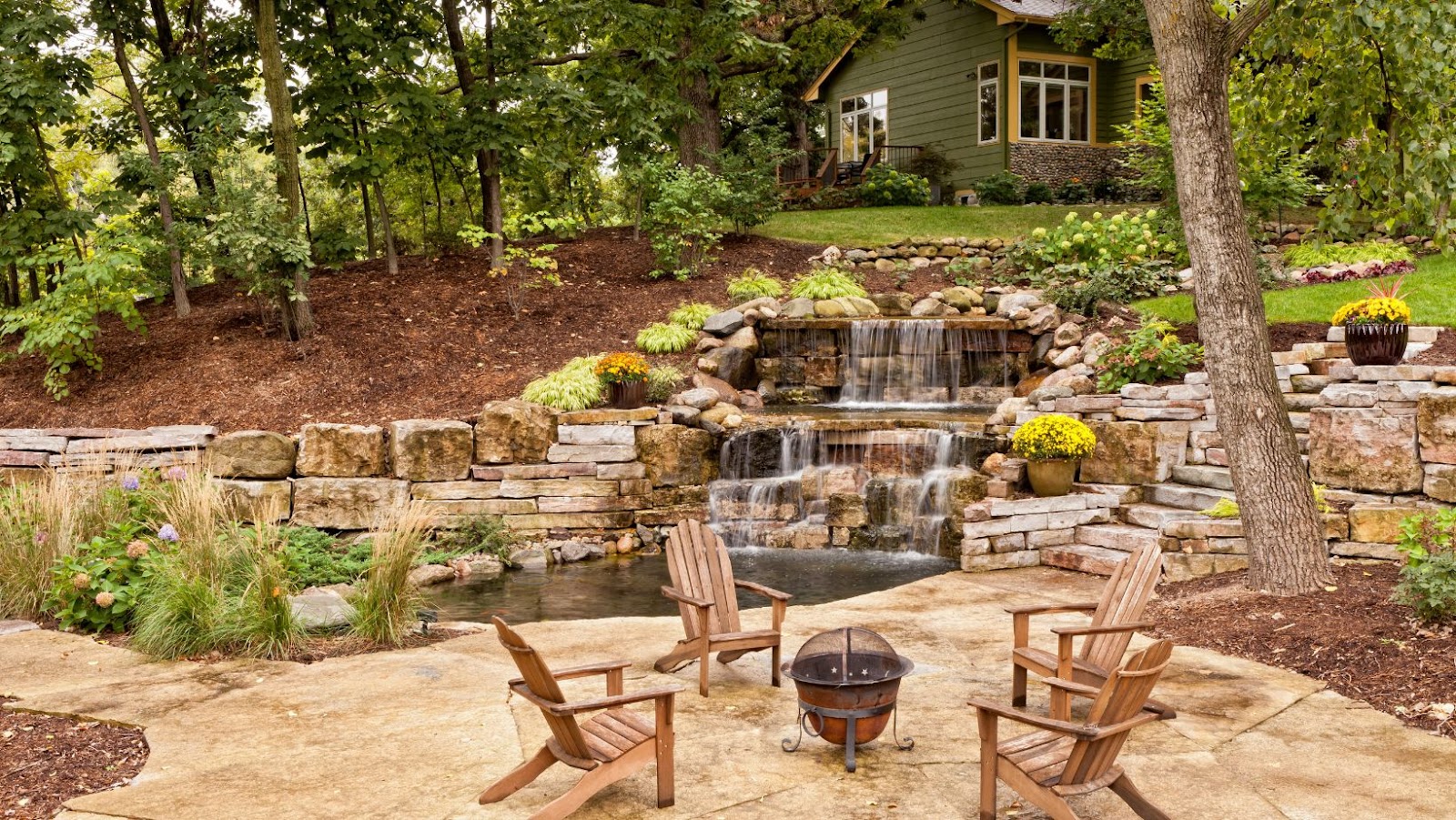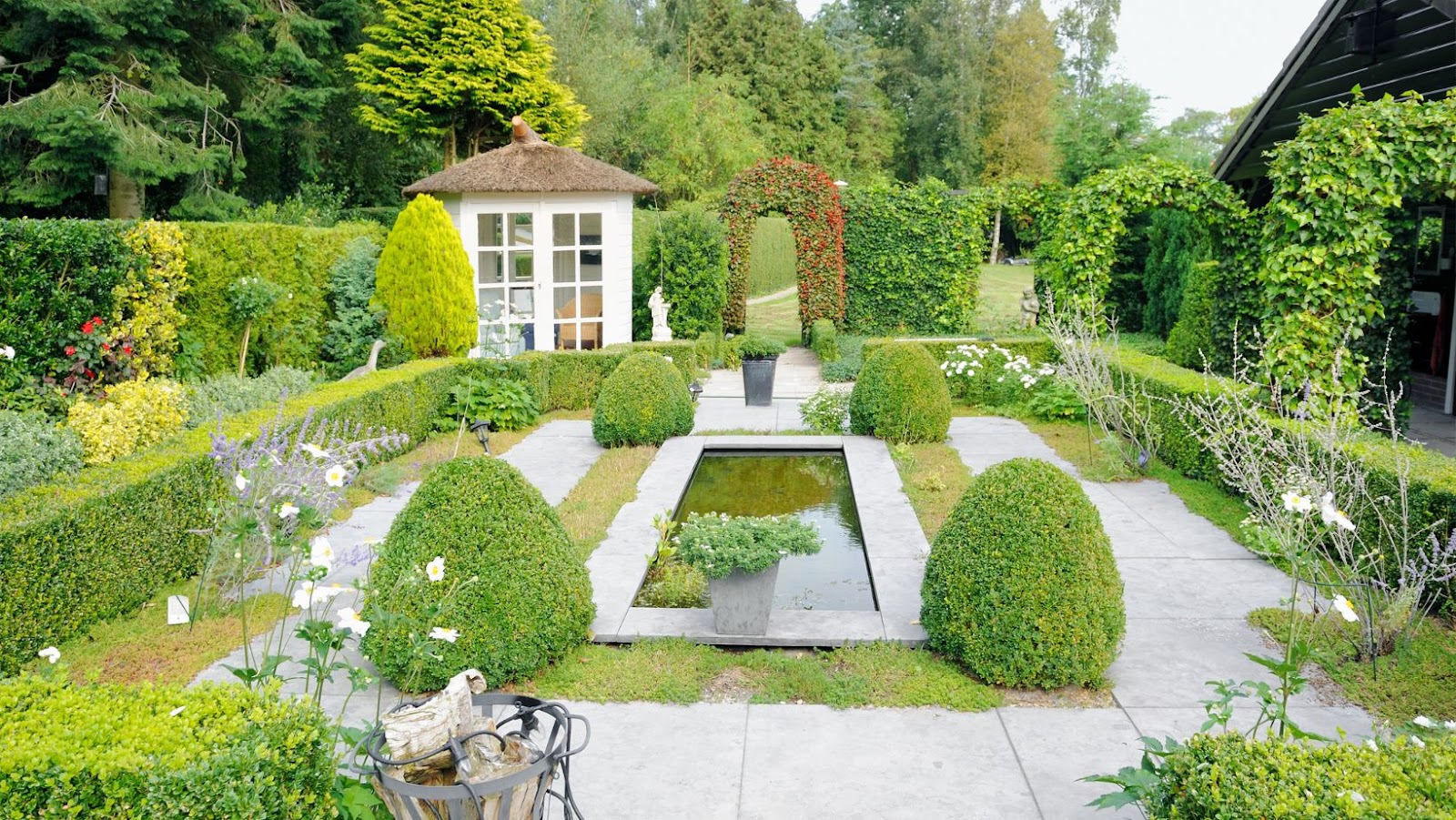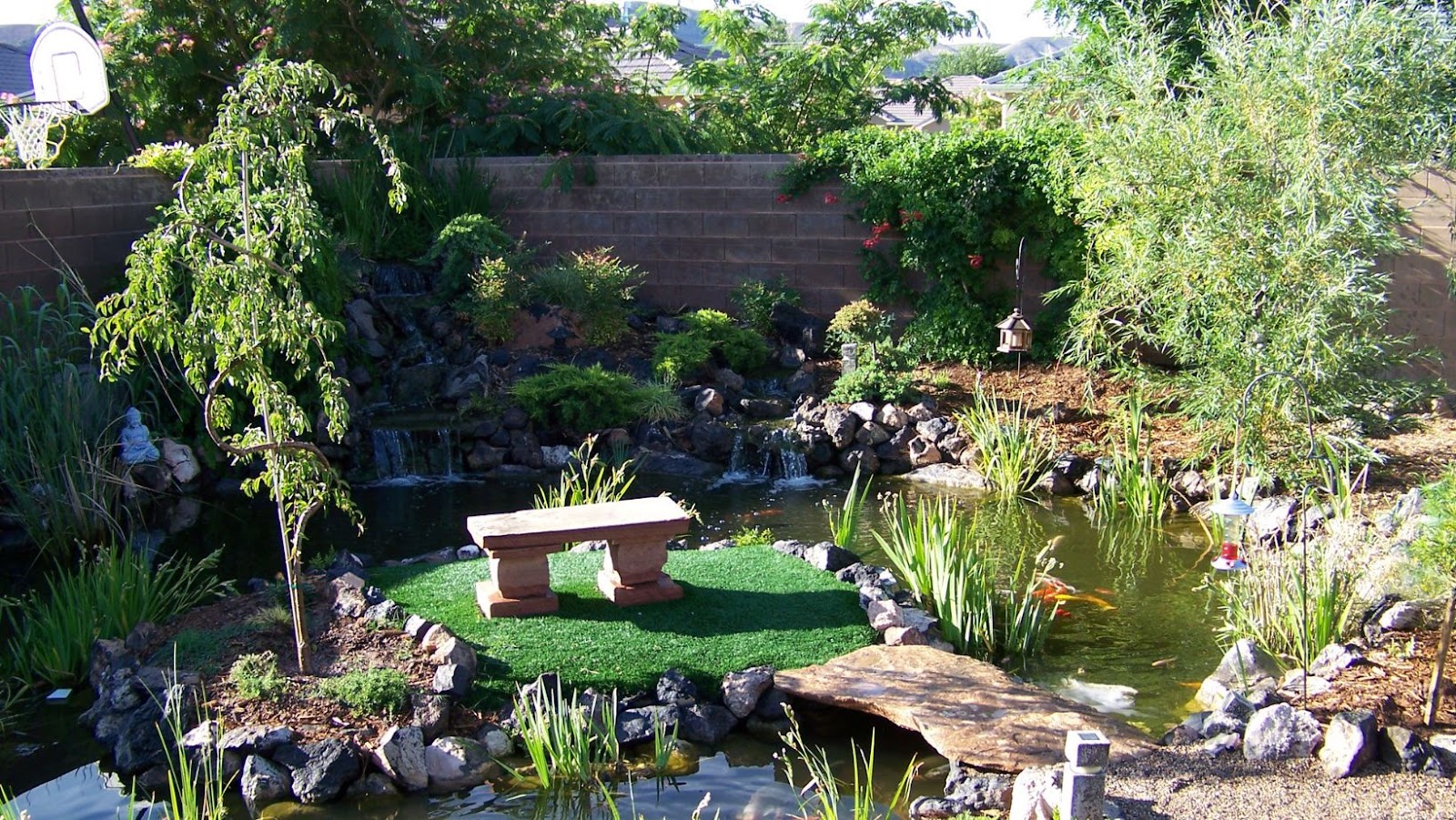Cleaning your backyard pond can be a daunting task yet it is important to keep your pond healthy and looking its best. Doing regular maintenance and cleaning work will help keep your pond healthy and functioning properly.
The cleaning process may include:
- Removing debris and algae.
- Testing the water quality.
- Adding new plants or fish if needed.
In this article, we’ll look at the steps to take to keep your backyard pond clean.
How to keep a backyard pond clean
Keeping your pond free from debris is a key part of your maintenance routine. The debris can build up quickly, and without regular removal, it affects the balance of the ecosystem. It is important to check the pond regularly and remove any leaves, sticks or other accumulated debris at least monthly.
If your pond has a fountain or waterfall, make sure to keep it clear of debris as well.
To remove the surface debris without disturbing any fish that might be present in the pond, you can use a hand net or long-handled dip net. Gently skim over the surface of the water until you’ve collected all visible matter floating on top. Dispose of this material responsibly as it can contain nutrients that feed aquatic plant growth if left in direct contact with water for too long.
In some cases where large volumes of debris are present in the water, it may be necessary to use a sump pump to help fish out mud and muck from the bottom of your pond. The sump pump should be installed with a mesh filter attached so that any debris being removed will not clog it or disrupt activity above ground level.
Vacuum the pond bottom
Vacuuming the pond bottom is an important part of keeping your backyard pond clean. The process is similar to vacuuming a swimming pool or hot tub and involves sucking up debris, such as leaves and other detritus, from the bottom of the pond with a special device.
To begin, you’ll need to purchase a submersible pond vacuum designed to run on a garden hose. Make sure that the vacuum has a filter attached so that dirt and other particles will not be passed back into your water when vacuuming.
Once you’ve set up your pond vacuum and placed it at the far end of the pond, start it up and apply slow back-and-forth motions as you move it along the bottom of your pond in its entirety. When vacuuming, make sure that you do not suck up any fish or aquatic plants inadvertently; if necessary move them out of the area that is being cleaned before starting the process. It also helps to use a time-release fertilizer after cleaning for additional algae control measures.
Use a pond skimmer to remove algae
Pond skimmers are essential tools for anyone who wants to keep a backyard pond clean. These devices remove debris, floating leaves, and algae from the surface of your pond.
Ideally, smaller debris like dirt and leaves should be filtered out before it has a chance to sink to the bottom. A properly functioning pond skimmer will strain out particles from the incoming water so that they never have a chance to reach the bottom of the pond.
Choose carefully when selecting a skimmer, as not all models will work well in any kind of pond – some are better suited for small ponds, others bigger ones. Decide which type best fits your needs before making your purchase and make sure that it is small enough to fit through any doorways or gates you may have into the backyard.
Using a pump or submersible fountain can also help keep large amounts of algae in your backyard pond under control by circulating water throughout the system. The increased movement keeps water oxygenated and prevents bacteria, fungus and other pathogens from growing there while inhibiting mosquito larvae growth due to frequent turnover rates.
Maintain Water Quality
Keeping your backyard pond clean and healthy is an important part of caring for your fish, plants, and other creatures living in it. Maintaining water quality is one of the most crucial steps to take to keep your pond in good condition.
Let’s discuss all the steps that you need to take to maintain water quality in your backyard pond:
Test the pond water regularly
Testing the water quality of your backyard pond is essential for keeping it clean and healthy. It can indicate the presence of dangerous toxins or algae that are harmful to plants and fish, as well as any pollutants that have entered the system. To test the water in your backyard pond, you should use a water testing kit to identify levels of pH, alkalinity, hardness, dissolved oxygen, nitrate, phosphate and/or other contaminants. This can help you determine what conditions are ideal for a healthy pond environment and quickly identify any problems that arise.
When testing your water regularly, it’s important to make sure to refer back to your test results over time so that you can easily tell when something has changed. If there is an unexpected change in the results or if they fall outside of the normal parameters for pond health, then it’s time to take action by cleaning or treating the water accordingly.
Balance the pH levels
Maintaining the ideal pH levels of your backyard pond is essential for maintaining water quality. Without proper pH balance, aquatic life such as fish, frogs, and other pond organisms can suffer greatly or die. The desired pH range that many experts approve of is between 6.5 and 8.5 since it is considered the neutral range in which most aquatic life thrives in an aquatic environment.
Testing the water’s pH levels should be done at least once a month during the warmer months and use test strips found in pet stores or at your local home improvement store to help identify if you need to adjust it. If you find that your pond’s pH level isn’t balanced, then you can:
- Add dechlorinated tap water from a local source to increase alkalinity
- Use driftwood or peat moss to decrease alkalinity in the pond’s water.
Doing regular checks on your pond’s pH levels will keep unwanted contaminants from overrunning your backyard pond habitat and will give a healthy thriving environment for aquatic life to inhabit and enjoy!
Add beneficial bacteria to the pond
One of the most important steps for keeping a healthy pond includes adding beneficial bacteria to your pond, which can effectively reduce nitrate levels and other pollutants. Beneficial bacteria feed on organic matter, preventing it from entering the water while also decreasing pond sludge deposits and reducing and eliminating noxious odors.
This bacteria should be added once every four to six weeks as a preventative measure to maintain a healthy water quality in your pond. Additionally, you can use a bio-filter if you want to keep your water even more clean. The bio-filter will promote bacterial growth on its media, removing chemical pollutants like iron, lead and suspended solids from the pond.
For larger backyard ponds, you can install a floating beneficial bacteria dispenser into the water that continuously releases specific strains of beneficial bacteria nutrients throughout the entire body of water.
Control Algae Growth
Keeping a backyard pond clean and free from algae is an important step in maintaining a healthy environment for aquatic life. Algae growth can quickly take over a pond if it is not kept under control, blocking out light and oxygen to the fish and other aquatic species.
There are a few steps you can take to make sure that algae growth is kept in check. Let’s look at a few of those steps in more detail:
Use an algae inhibitor
Algae growth in backyard ponds can be fun to watch, but it can also become overbearing when not kept in check. Excessive algae growth can cloud the water and starve oxygen off of other aquatic life living in the pond. To control algae growth, there are several steps you should take. An important step is to use an algae inhibitor or algaecide.
Algaecides are a type of herbicide that are commonly used to control certain types of algae in backyard ponds. Algaecides work by preventing algae from hosting photosynthesis or eliminating the spores from which it grows. When used properly, algaecides can prevent future outbreaks of algae and significantly reduce current outbreaks of existing algae colonies.
When using algicides, always follow package instructions on how to mix with water, as well as how much product to apply per given surface area size – over-application may cause more harm to pond life than good! Many formulations require a pretreatment before they provide results and must be added regularly throughout the summer months. Additionally, some algicides have copper-based formulation, so it’s important to note that copper is toxic when present at too high concentrations; take extra care and precautions when utilizing copper-based products. Doing so is essential for proper management of your pond’s ecosystem as a whole!
Plant aquatic plants
Aquatic plants are a great way to naturally control algae growth while beautifying your pond. Include several aquatic plants of multiple species, like the common water lily, water lettuce, and parrot’s feather. Not only do pond plants provide oxygen and shade that helps reduce algae growth, but they can also pull extra nutrients from the water, such as nitrate and phosphate. As a result, there will be less free nitrogen in the pond for algae to use as it grows.
Most aquatic plants need at least 8 hours of direct sunlight per day; if possible, choose a location within your backyard that offers full sun exposure. Additionally, you’ll want to make sure there is enough room for these aquatic plants since they can spread wide and take over the pond. Be sure to research different varieties of aquatic plants available for your area to determine which is best for you!
Install a UV sterilizer
UV sterilizers are one of the best ways to keep your backyard pond clean. A UV sterilizer works by passing water through a filtration system that contains an ultraviolet light to kill algae, bacteria and other microorganisms. By doing this, it keeps the number of potential sources for algae growth down to a minimum.
Additionally, it prevents further growth in your pond by eliminating desirable food sources for them and killing off any free floating spores that may have been introduced from other ponds or streams. Installing a UV sterilizer will ensure you have a crystal-clear pond that you can enjoy with minimal effort required on your part.
Monitor Wildlife
If you want to keep your backyard pond clean, the first step is to monitor the wildlife around your pond. Regularly check for algae and debris buildup in the water, and make sure that your pond is free from any toxic materials. Check the water levels, and note the presence of fish, frogs, dragonflies, and other insects. Keeping a watchful eye on the wildlife in and around your pond will help you determine when you need to take action to maintain a clean, healthy environment.
Check for signs of disease in fish
It is important to identify signs of disease in fish to keep the pond clean and healthy. Symptoms can include loss of appetite, spots and cloudiness on the skin or eyes, changes in activity level, breathing difficulty, floating or struggling near the surface of the water, other signs such as fin damage or overall color changes. If any of these are noticed, act quickly by having your fish examined by a qualified professional. Adding products such as an antibacterial solution or stress coat to the pond can help reduce infection while a veterinarian examines any sick fish.
In addition to checking for other signs of illness, it is a good idea to regularly check the water pH balance which should be between 6.8-7.2. Feeling around for bumps on your fish can also indicate possible health issues like parasites; signs to look for include white film in their vision or bulging eyes beyond their usual size. These are all important steps to take in order for you to monitor and protect fish from diseases that could potentially spread and contaminate your pond if action isn’t taken early enough.
Check for signs of predators
When monitoring wildlife in your backyard pond, one of the first steps to take is to check for signs of predators. This includes look for waterfowl such as ducks or geese, birds of prey such as hawks and owls, rodents like mice and rats, or any other animal that can fit into the pond. If you notice any of these predators coming around your pond, consider taking action immediately by installing a physical barrier or introducing a repellent. Additionally, it can be beneficial to install motion-sensitive lights around the perimeter of your backyard pond if there are too many nocturnal visitors.
In addition to checking for signs of predators, it is important to monitor any fish living in the backyard pond. Look out for signs that they are not thriving such as physical deformities or ailments caused by parasites including gill flukes and anchor worms. Furthermore, if you notice that some fish are severely overpopulating the pond and leading to stunted growth among its occupants, then it may be necessary to relocate some of them into another environment with more adequate food resources available. If all else fails and your backyard pond still attracts unwanted visitors like large animals from nearby farms such as cows or horses, then consider investing in a series of electric fences around the perimeter of the yard.
Monitor water levels
It is essential to monitor water levels in your backyard pond, as they can change due to rainfall, evaporation, incoming groundwater and other factors. In order to maintain a healthy environment for pond wildlife and prevent the growth of algae and other aquatic weeds, the water level should be monitored regularly. Make sure that the pond is not too deep or shallow.
To do this, you should:
- Measure the water depth regularly and take appropriate action to fill or drain the pond if needed, or use a mechanical system like an auto-fill valve that can compensate for changes in the water level automatically.
- Be careful not to overfill your pond; look for signs of overflowing, such as when ponds start rising uncontrollably (this could mean they are being filled too quickly). If this happens, lower the level of your pond by either manually emptying it with a bucket or using a pump.
Moreover, it is important to check on possible sources of water loss such as leaky pipes or broken seals throughout the year. Additionally, during periods of heavy rainfall check your drains to make sure there is good drainage and that excess water is being channelled away from your backyard pond rather than leading into it. Making sure runoff from other areas such as roofs and driveways are channeled away from ponds can ensure their safety from overfilling.
Regular Maintenance
Keeping your backyard pond clean is an essential part of making sure you and your family can enjoy its beauty. Regular maintenance is the key to keeping your pond healthy, and the first step is to establish a maintenance schedule. This schedule should include checking the water chemistry, cleaning the pond filter, and doing regular water changes.
In this article, we’ll walk you through the steps to take to keep your backyard pond clean:
Change the water regularly
Changing the water in a backyard pond on a regular basis is key to keeping it clean and healthy for plants and fish. You should replace between 20-50% of the water every two weeks, or every month depending on the size of your pond. When changing the water, use a garden hose with a nozzle that can be used to siphon out the old water and top up with fresh, clean water. This helps to minimize any shocks from sudden temperature changes or changes in pH levels which could be dangerous for your fish and plants.
You should also take care to aerate the water regularly; if there’s too little oxygen in the water, it can lead to poor health of both fish and plants. You can use pumps or other aerators such as waterfall pumps to help increase and maintain sufficient oxygen levels in your pond.
Additionally, adding beneficial bacteria and commercial pond treatments can help break down debris and algae buildup while replenishing essential minerals like calcium carbonate which acts as a natural buffer against dramatic pH swings in your pond.
Clean the pond filter
Pond filters play a vital role in maintaining good water quality. Regularly cleaning the filter will help to keep the water sparkling clean and clear. Depending on the size of your pond, you will need to either manually clean or backwash your filter regularly.
For manual cleaning, remove the mesh bag with the biological media, shake it gently and remove any debris before rinsing with pond water and returning to the filter. For larger ponds, regularly backwashing as part of routine maintenance is recommended as a more thorough method of cleaning. This requires disconnecting from power and turning off tap valves before remediating the clogging problem. Once finished, reconnect taps valves and restart pump power slowly to prevent any potential leaks or water spouts from blockers being misaligned or panel cracks etc.
Additional regular maintenance tasks include:
- Changing upholstery foam filled in your filter for newer versions to maintain quality pond filtration levels for optimal results.
- In summer seasons where plants bloom abundantly, you may need even more frequent backwashing than usual to keep soil sediments from building up in your pond filters quicker than average timescales.
Pond maintenance doesn’t have to be tedious when done right; regular upkeep goes a long way towards keeping a healthy backyard fish pond all year round!
Trim plants and remove dead foliage
Plants play an important role in creating a sustainable environment for your pond. However, if these plants are not managed regularly, they can become unruly and take over the entire tank. This can create a fluctuation in water chemistry due to the high levels of organic matter and reduce oxygen levels. To mitigate this issue, it is important to regularly trim overgrown plants and remove any dead foliage from the pond.
You should also limit the amount of nutrients going into the pond. Nitrogen from fish food or fertilizer runoff from your garden can result in algal blooms beneath surface scum called “pea soup algae”. To promote healthy vegetation growth without excessive nitrogen inputs you are required to ensure that all dead plant matter is removed from the pond at least once every month during summers and twice or three times per year during winters.
Preventing debris accumulation in your backyard pond will also help maintain good water quality and clarity by providing enough oxygenation for aquatic wildlife as large debris accumulations interfere with circulation which cause nutrient deprivation in many parts of your pond environment resulting in degraded water quality, decreased oxygen levels or even death of aquatic life species such as fish, frogs or invertebrates. You should pay close attention to areas where you have heavily planted ponds as these tend to accumulate more debris due to faster decomposition rates there than open-water zones like streams and rivers do. Remove any leaves and twigs from these areas at least every other day as decomposition rate is much faster here than on non-vegetated habitats .








